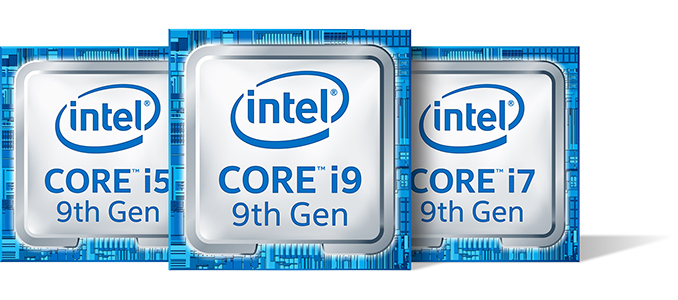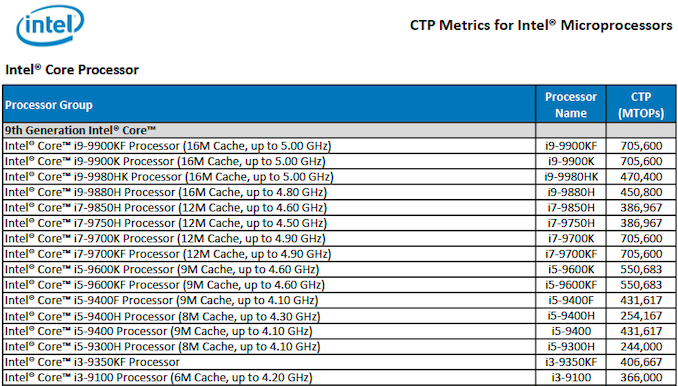Intel Details New 9th Gen CPUs for Notebooks: i9-9980HK to i5-9300H
by Anton Shilov on February 16, 2019 11:00 AM EST- Posted in
- CPUs
- Intel
- Coffee Lake
- Core 9th Gen
- i9-9980HK

Intel is yet has to announce its 9th Gen Core processors for laptops officially, but because the company needs to sort out all the things with authorities and regulators well in advance of actual product launches, CPU model numbers and general specifications have been published well ahead of the formal release. As it turns out, recently the company disclosed the first details about its 9th Gen mobile Core i9, Core i7, and Core i5 H-series processors for higher-end laptops.
Before proceeding to the actual products, let us make it clear what Intel actually revealed. Among other things, Intel (and other companies) has a number of export compliance metrics for its CPUs, including GFLOPS, Adjusted Peak Performance (APP), and Composite Theoretical Performance (CTP). These metrics are used by various governments to determine capabilities of CPUs and other processors. The APP and GFLOPS metrics are used by the US Department of Commerce’s Bureau of Industry and Security (BIS). Meanwhile, other authorities and regulators use CTP calculations, which are stated in Millions of Theoretical Operations Per Second (MTOPS), to assess what companies import to their countries. The CTP numbers are the ones that Intel published for its yet-to-be released CPUs.
The mobile CPUs newly listed are the eight-core Core i9-9980HK processor with unlocked multiplier, the eight-core Core i9-9880H, the eight-core Core i7-9850H, the eight-core Core i7-9750H, the quad-core Core i5-9400H, and the quad-core Core i5-9300H. All of them are aimed at high-performance laptops for gamers and professionals and, according to Intel, will be launched in the second quarter. Since the new processors belong to Intel’s 9th Gen Core family are designed to feature hardware mitigations against specific Meltdown and Spectre vulnerabilities. Meanwhile, a quick look at the basic specs that Intel published as well as their CTP numbers can shed some light on general specifications of the upcoming 9th Gen Core H-series mobile processors.
| Intel 9th Gen Core CPUs for Desktops and High-End Notebooks | |||||||||
| Tier | Model | Application | Cores | Base Freq |
Turbo Freq |
L3 | IGP | IGP Freq |
TDP |
| i9 | i9-9900K | Desktop | 8 / 16 | 3.6 GHz | 5.0 GHz | 16 MB | UHD 630 | 1200 | 95 W |
| i9-9900KF | Desktop | 8 / 16 | 3.6 GHz | - | - | 95 W | |||
| i9-9980HK | Notebook | 8 / 16 | ? | UHD 630 (?) | ? | ? | |||
| i9-9880H | Notebook | 8 / 16 | ? | 4.8 GHz | ? | ? | |||
| i7 | i7-9700K | Desktop | 8 / 8 | 3.6 GHz | 4.9 GHz | 12 MB | UHD 630 | 1200 | 95 W |
| i7-9700KF | Desktop | 8 / 8 | 3.6 GHz | 4.9 GHz | - | - | 95 W | ||
| i7-9850H | Notebook | 8 / 8 | ? | 4.6 GHz | UHD 630 (?) | ? | ? | ||
| i7-9750H | Notebook | 8 / 8 | ? | 4.5 GHz | ? | ? | |||
| i5 | i5-9600K | Desktop | 6 / 6 | 3.7 GHz | 4.6 GHz | 9 MB | UHD 630 | 1150 | 95 W |
| i5-9600KF | Desktop | 6 / 6 | 3.7 GHz | 4.6 GHz | - | - | 95 W | ||
| i5-9400 | Desktop | 6 / 6 | 2.9 GHz | 4.1 GHz | UHD 630 | 1050 | 65 W | ||
| i5-9400F | Desktop | 6 / 6 | 2.9 GHz | 4.1 GHz | - | - | 65 W | ||
| i5-9400H | Notebook | 4 / 8 | ? | 4.3 GHz | 8 MB | UHD 630 (?) | ? | ? | |
| i5-9300H | Notebook | ? | 4.1 GHz | ? | ? | ||||
| i3 | i3-9350KF | Desktop | 4 / 4 | 4.0 GHz | 4.6 GHz | - | - | 91 W | |
| i3-9100 | Desktop | ? | ? | 4.2 GHz | 6 MB | UHD 630 (?) | ? | ? | |
NOTE 1: Keep in mind that Intel has only published very basic specificationsof its upcoming 9th Gen Core CPUs for notebooks (i.e., Turbo frequency and cache size), which is why a number of details published here (e.g., core count, iGPU) are not confirmed officially at this point.
Obviously, the Core i9-9980HK and the Core i9-9980H will sit on top of the range offering eight cores with Hyper-Threading, 16 MB of L3 cache as well as Turbo frequencies close to their desktop counterparts. Meanwhile, the difference between CTP of desktop Core i9 and notebook Core i9 CPUs clearly indicates that their base clocks will be considerably lower, possibly to maintain a 45 W TDP.
Intel’s Core i7-9850H and the Core i7-9750H processors will sit below their Core i9-branded brethren. These chips will feature eight cores (without HT) capable of running at up to 4.6 GHz along with 12 MB of L3 cache. Just like in case of higher-end parts, these CPUs will be clocked considerably lower than their desktop colleagues.
Surprisingly, as far as the cache size and CTP numbers are concerned, the 9th Gen Core i5 H-series processors will not feature six cores, but will pack four Hyper-Threaded cores with 8 MB of L3. While the Core i5-9300H chip will probably run faster than the Core i5-8300H, the Core i5-9400H will have exactly the same base frequency as the Core i5-8400H as they have the same CTP of 254,167 MTOPS.
In addition to mobile CPUs, Intel also disclosed some preliminary details about its entry-level quad-core Core i3-9100 CPU in its document. The chip will run at frequencies of up to 4.2 GHz and will feature 6 MB of L3 cache. Since this is a lower-end part, expect it to be priced accordingly.
As always, Intel does not comment on unreleased products, so take every unconfirmed spec mentioned here with a grain of salt. What we do know for sure at this point is that Intel has finalized specs of its 9th Gen Core H-series processors for laptops and, if everything goes as planned, is on track to launch them in Q2 2019.
NOTE 2: The screenshot of Intel’s document above has been altered in order to better represent the topic of the news story. The original document looks as follows:
Related Reading
- Playing Chicken: Kentucky Fried Intel Core i9-9900KFC Processor Listed
- Intel’s New 9th Gen Desktop CPUs: i3-9350KF, i5-9400F, i5-9400, i5-9600KF, i7-9700KF, i9-9900KF
- The Intel 9th Gen Review: Core i9-9900K, Core i7-9700K and Core i5-9600K Tested
- Analyzing Core i9-9900K Performance with Spectre and Meltdown Hardware Mitigations
- Intel Announces 9th Gen Core CPUs: Core i9-9900K (8-Core), i7-9700K, & i5-9600K
- Intel Coffee Lake Refresh: Global Price Check on 9900K, 9700K, 9600K

















37 Comments
View All Comments
boeush - Sunday, February 17, 2019 - link
It's unfortunate that most laptop designs these days, especially from the biggest OEMs, trend toward thin-and-light rather than fast-and-cool. Yes, there's a clear demand for the former, but there is unfulfilled demand for the latter.All the advancements in chip, battery, screen, storage tech - but somehow cooling is just an afterthought, and mobile workstation CPU TDP has been stuck at paltry 45 W, for a decade. Why can't we have some sort of advanced materials or liquid cooling or whatever, to bring that mobile CPU TDP capability at the high-end (so what, if thick-and-heavy DTR-style) up to 65, or even 90 W? Even in absence of advanced tech, it clearly can be done for mobile GPUs; why can't it be done for mobile CPUs?
Yes, there's the option of going with a boutique design like Sager that sticks a desktop CPU into a DTR notebook form factor, but one still worries about thermal throttling even with those builds... Besides, a full-on desktop CPU isn't optimal for good battery life when doing light computing off the mains. Maybe the ideal configuration would be something like ARM's big.LITTLE: a couple of lightweight, low-TDP mobile cores paired with a set of high-TDP desktop cores for when you need that grunt, coupled with a dual-mode cooling system that can run efficiently at low TDPs or kick into high-power mode when high TDP is needed. One can dream...
yankeeDDL - Monday, February 18, 2019 - link
The short answer to your question is physics. 45W is "a lot" of heat to be dissipated. Have you seen the size of heatspreader for a 65W desktop CPU?45W is already a huge amount for a portable device.
What this article shows is that, today, cooling solution for 45W, on portable devices, are largely inadequate. It is not the first time, and won't be the last.
I am looking forward to laptop based on the 3750U (https://www.amd.com/en/products/apu/amd-ryzen-7-37... which uses "only" 35W, and this includes a beefy GPU. I think it is a better balance, than a 45W CPU with 8 cores and an "anemic" GPU.
Nexing - Tuesday, February 19, 2019 - link
Or the reverse question; Why can't INTEL have some sort of advancement, to bring 10, 7, 5 and 3 nm to the table like Samsung or TSCM are on their way or doing. I refuse to buy the idea that its only cause it keeps outstandingly selling at 14nms.Meanwhile, users needing mobile solutions with highly demanding sequential loads are been deprived of high GHz working CPUs at lower TDPs, precisely the main benefit smaller lithography has.
Zingam - Friday, February 22, 2019 - link
Do you have any explanation why hyperthreading is out?hackness - Friday, February 22, 2019 - link
You can actually trick the CPU by adding a negative offset to the reported TDP, if your actual wattage is bumping to 60W and you have an offset of -32W, the CPU will think that you are running at 28W and the PL1 throttle will never kick in.Search for IMON tweak in google and you'll find more info.
berkkocaturk - Wednesday, March 6, 2019 - link
For comparison on my 8750H i get average 3.9 GHZ on all cores on idle and on gaming i get turbo to max frequency too only on video encoding (and heavy tasks) i get stable 3GHZ on all cores but it is with custom curve so new cpus may handle more than mine i am guessingB-29_Bomber - Monday, April 22, 2019 - link
How accurate is that core count for the 9750H? I read on an Acer Predator Helios 300 2019 article that its only a 6 core 12 thread CPU...